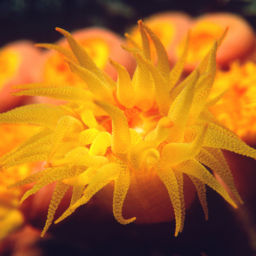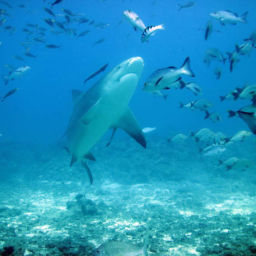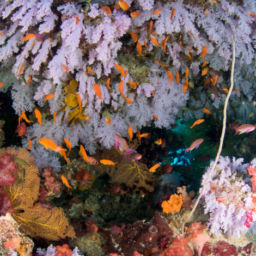Divers are spoiled for choice in Fiji, where a wealth of dive sites await. Some of the best are in the Yasawa Islands, which number around 20. They are volcanic, featuring dramatic peaks rising up to 1,900 feet (600 m) with similarly dramatic topography underwater. Most of the islands have fringing reefs with walls, gullies, swim-throughs and caves to explore. Divers are likely to see manta rays, numerous sharks, tropical fish and pristine coral reefs. The diving on these uncrowded and peaceful islands is suitable for all experience levels. To get there, choose from a handful of options for liveaboard diving.
Here are our top picks for dive sites in the Yasawa Islands.
Naviti Island
Naviti Island is one of the highest of the Yasawas, with a maximum elevation of 1,273 feet (388 m). It’s quite popular for hiking and offers a unique dive at Babylon Caves as well. Divers begin by swimming between two huge walls that end in a T-shaped path. You’ll go left or right, exploring more paths and turns and entering a large cave system. The complex caves require a lot of navigation before exiting and swimming along a reef-capped wall, so you must be certified and competent in cave diving. There are also easier dives for new divers with plenty of hard-coral cover and marine life. In the channel south of Naviti, divers and snorkelers can enjoy manta-ray encounters at the manta-cleaning stations.
Barefoot Manta Island
Known locally as Drawaqa Island, this island lies to the south of the Yasawas. True to its name, Barefoot Manta Island is famous for manta-ray encounters. Divers can swim with them from May to October each year. This peaceful island also features some of the best coral gardens in Fiji.
Tavewa Island
Tavewa Island is relatively flat compared to other Yasawa Islands and is home to a diverse selection of dive sites. Tucked between Tavewa and Nacula Islands, the Zoo is especially popular. The steep wall at this site drops to beyond 164 feet (50 m). Nutrient-rich currents wash the site, attracting plenty of pelagic species. Overhangs and vibrant coral gardens feature black-coral trees, sea whips and colorful hard corals. Divers can see barracuda, Spanish mackerel, trevally, snappers, groupers and numerous reef sharks.
The Cabbage Patch dive site at Tavewa is a good choice for novices, with huge cabbage corals, reef fish and ghost pipefish. Tavewa Breakers is a good wall dive for new and experienced divers while Golden Nugget is great for photographers who want to see stonefish, scorpionfish, leaffish and hairy ghost pipefish. The Ethel wreck; a broken-up 19th century steamship off Tavewa, features propellers, anchors and engines and is a great spot to see colorful nudibranchs.
Sawa-i-Lau Island
Sawa-i-Lau is famous for its spectacular caves and is one of the few places in the world where you can see ancient paintings and inscriptions underwater. You can also enter a secondary cavern via an underwater dive passage.
The Maze dive site has fascinating reef structures, with a series of swim-throughs, caves and canyons to explore. There is good hard-coral cover, home to numerous fish, crayfish, visiting sea turtles, and occasional bumphead parrotfish. The pinnacles at Rusty’s also have plenty of fish life, plus huge stingrays. Fans of whitetip reef sharks should dive Nova Point and keep an eye out for them on the reef edge. Smurf’s dive site features colorful Christmas tree worms and tawny nurse sharks hiding under the overhangs. Rusty’s and Smurf’s are both suitable for new and experienced divers.
Nanuya Lailai Island
This highlight of the Yasawa Islands features a coral lagoon that has great snorkeling, palm-fringed shores and idyllic white-sand beaches. Divers might recognize the scenery as the setting for the famous Blue Lagoon movies of 1949 and 1980. While not technically a dive site, the lagoon is well worth snorkeling to see crystalline blue waters featuring tropical fish and reef sharks.
When to go
The Yasawa Islands are the driest and warmest area in Fiji, with sunshine most of the year. Visibility is best from July to December, when the water temperature is coolest at 72 to 77 F (22 to 25 C). September is a particularly good month to visit, with low humidity and cooler water that results in visibility of over 100 feet (30 m). The best time to visit for manta rays is May to October.
This article was written by divers and writers at LiveAboard.com





